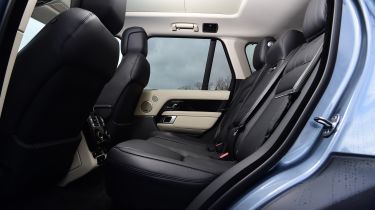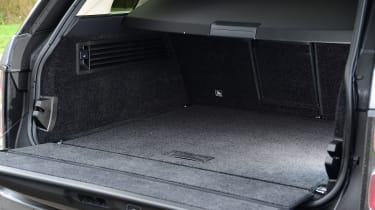Range Rover SUV (2012-2022) - Practicality & boot space
There’s plenty of room in the Range Rover for a driver and four passengers, as well as loads of boot space
Anyone who's ever seen a Range Rover can tell you just how large it really is – at five metres long, there's not much on the road that’s bigger. That obviously means loads of space inside, but it's not much fun when it comes to negotiating narrow streets or squeezing into tight parking spaces. The long-wheelbase model is even bigger, so you’ll have to make sure you're not short on garage or driveway space.
Range Rover interior space & storage
Thanks to the Range Rover's considerable length, width and height, there's no shortage of space inside this large SUV. The big seats in the front are superb and there's enough room for the tallest or widest of occupants.
It's the same story in the back: few models provide this much space. But if that's still not enough, the long-wheelbase model increases rear legroom enormously.
Most models have space for five, but a four-seat option ditches the middle rear seat to create storage space and more room for the two remaining back-seat passengers. It feels wonderfully opulent, but choosing this option means you can't fold the rear seats down, although you can recline them.
There's lots of storage space, too. The dashboard has two gloveboxes, there are big pockets in the doors and centre console and you can even specify a fridge between the front seats.
More reviews
The bad news, though, is that the Range Rover feels huge. It can be difficult to get into it unless you use the 'access height' function, which temporarily drops the suspension by 50mm to let you climb in.
Once inside, you'll find the Range Rover's huge dimensions make driving it a bit tricky. It's a good job that you get large windows and big mirrors, and that you can see the bonnet edges from behind the wheel, because this all helps you to place the car on the road.
Land Rover offers plenty of gadgets to help make life easier for you, including a rear-view camera that comes as standard across the range. Then there's an automatic parking system to help with parallel and perpendicular parking, a system to alert you of traffic while you're reversing out of a space and a 360-degree camera, too.
If you want a bit more space in the rear, Land Rover also offers a long wheelbase version of the Range Rover for an extra £7,000.
Boot space
First, the good news: the Range Rover has a massive 909-litre boot. If you need to put that into perspective, just consider that the practical Volkswagen Golf family hatchback has a 380-litre boot.
If you ever need more space than that, then you can just flip the rear seats forward to more than double the amount of storage up to 2,030 litres – as long as you haven’t gone for the two-rear-armchairs option.
All models get a powered split tailgate as well: you just press a button on the key to open the boot. The bottom half of the tailgate also folds out, giving you somewhere to sit while you take your muddy shoes off, or simply a way to slide big, heavy items into the boot. Recent revisions to the car included a hands-free boot opening feature.
Towing
It's a safe bet that a lot of Range Rover buyers will use their cars for towing – and it certainly boasts some impressive figures. The D300 diesel can tow an unbraked trailer, caravan or horsebox weighing up to 750kg and a maximum braked load of 3,500kg.
Those figures also apply to the D350 diesel, P400 and the V8 supercharged petrol models, while the P400e plug-in hybrid has a slightly reduced towing limit of 2,500kg. All Range Rovers have a maximum roof-rack load limit of 100kg, including the weight of the roof rails.














